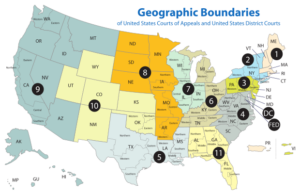The United States federal court system is a hierarchical structure consisting of three levels: the district courts, the courts of appeals, and the Supreme Court. District courts are trial-level courts who have jurisdiction over a wide range of federal cases, including criminal cases, civil cases involving federal law, and cases involving federal agencies. The courts of appeals are intermediate appellate courts, who hear appeals from the district courts and other federal agencies within their geographic jurisdiction. The Supreme Court is the highest court in the United States, and has the final say on all cases involving federal law and the United States Constitution.
 The federal court system was established by the Constitution, which gives Congress the power to create and regulate federal courts. Our first federal courts were created by the Judiciary Act of 1789, which only established district courts and the Supreme Court. The Act also created the Office of the Attorney General and provided for the appointment of federal judges by the President, with the advice and consent of the Senate.
The federal court system was established by the Constitution, which gives Congress the power to create and regulate federal courts. Our first federal courts were created by the Judiciary Act of 1789, which only established district courts and the Supreme Court. The Act also created the Office of the Attorney General and provided for the appointment of federal judges by the President, with the advice and consent of the Senate.
Over time, the federal court system has evolved and expanded to meet our country’s changing needs. The number of federal district courts and judges has increased while new courts of appeals have been established.
The United States Court of Appeals for the Fourth Circuit (in case citations, 4th Cir.) is a federal court with appellate jurisdiction over the district courts for the following districts:
- District of Maryland
- Eastern District of North Carolina
- Middle District of North Carolina
- Western District of North Carolina
- District of South Carolina
- Eastern District of Virginia
- Western District of Virginia
- Northern District of West Virginia
- Southern District of West Virginia
The court is based at the Lewis F. Powell Jr. United States Courthouse in Richmond, Virginia.
Landmark Fourth Circuit rulings include:
- Loving v. Virginia (1967) – holding that Virginia’s ban on interracial marriage was unconstitutional, striking down the last such ban in the United States.
- United States v. Hamad (2015) – upholding the conviction of a man who provided material support to terrorists and the use of secret evidence in the trial.
- North Carolina v. Covington (2017) – holding that North Carolina’s congressional redistricting plan was an unconstitutional partisan gerrymander.
- ACLU v. Clapper (2013) – ruling that the National Security Agency’s (NSA) collection of phone records was likely unconstitutional.
- United States v. Scheffer (1998) – establishing that military courts-martial could admit reliable polyggraph evidence in limited circumstances.
These cases highlight the Fourth Circuit’s role in shaping important legal issues, such as individual rights, national security, and the balance of power between different branches of government.